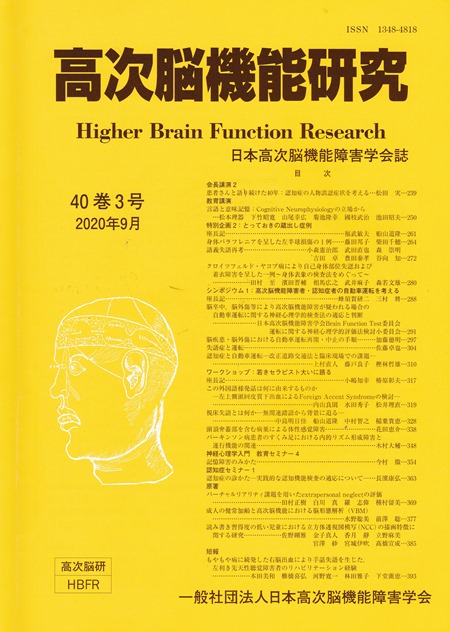Volume 40, Issue 3
Displaying 1-22 of 22 articles from this issue
- |<
- <
- 1
- >
- >|
President's lecture 2
-
2020Volume 40Issue 3 Pages 239-249
Published: September 30, 2020
Released on J-STAGE: October 01, 2021
Download PDF (1648K)
Educational lectures
-
2020Volume 40Issue 3 Pages 250-260
Published: September 30, 2020
Released on J-STAGE: October 01, 2021
Download PDF (1246K)
Special program 2 : Treasured Cases from the “Brewery”
-
2020Volume 40Issue 3 Pages 261-263
Published: September 30, 2020
Released on J-STAGE: October 01, 2021
Download PDF (275K) -
2020Volume 40Issue 3 Pages 264-271
Published: September 30, 2020
Released on J-STAGE: October 01, 2021
Download PDF (647K) -
2020Volume 40Issue 3 Pages 272-279
Published: September 30, 2020
Released on J-STAGE: October 01, 2021
Download PDF (1235K) -
2020Volume 40Issue 3 Pages 280-287
Published: September 30, 2020
Released on J-STAGE: October 01, 2021
Download PDF (581K)
Symposium 1 : Neuropsychological fitness to drive in patients with higher brain dysfunctions and dementia
-
2020Volume 40Issue 3 Pages 288-290
Published: September 30, 2020
Released on J-STAGE: October 01, 2021
Download PDF (226K) -
2020Volume 40Issue 3 Pages 291-296
Published: September 30, 2020
Released on J-STAGE: October 01, 2021
Download PDF (478K) -
2020Volume 40Issue 3 Pages 297-303
Published: September 30, 2020
Released on J-STAGE: October 01, 2021
Download PDF (634K) -
2020Volume 40Issue 3 Pages 304-309
Published: September 30, 2020
Released on J-STAGE: October 01, 2021
Download PDF (429K) -
2020Volume 40Issue 3 Pages 310-316
Published: September 30, 2020
Released on J-STAGE: October 01, 2021
Download PDF (635K)
Workshop : Talks by four young and spirited therapists
-
2020Volume 40Issue 3 Pages 317-318
Published: September 30, 2020
Released on J-STAGE: October 01, 2021
Download PDF (223K) -
2020Volume 40Issue 3 Pages 319-327
Published: September 30, 2020
Released on J-STAGE: October 01, 2021
Download PDF (685K) -
2020Volume 40Issue 3 Pages 328-337
Published: September 30, 2020
Released on J-STAGE: October 01, 2021
Download PDF (650K) -
2020Volume 40Issue 3 Pages 338-347
Published: September 30, 2020
Released on J-STAGE: October 01, 2021
Download PDF (810K) -
2020Volume 40Issue 3 Pages 348-353
Published: September 30, 2020
Released on J-STAGE: October 01, 2021
Download PDF (439K)
Introduction to neuropsychology Educational seminar 4
-
2020Volume 40Issue 3 Pages 354-362
Published: September 30, 2020
Released on J-STAGE: October 01, 2021
Download PDF (660K)
Seminar on Dementia I
-
2020Volume 40Issue 3 Pages 363-368
Published: September 30, 2020
Released on J-STAGE: October 01, 2021
Download PDF (478K)
Original article
-
2020Volume 40Issue 3 Pages 369-376
Published: September 30, 2020
Released on J-STAGE: October 01, 2021
Download PDF (726K) -
2020Volume 40Issue 3 Pages 377-384
Published: September 30, 2020
Released on J-STAGE: October 01, 2021
Download PDF (611K) -
2020Volume 40Issue 3 Pages 385-392
Published: September 30, 2020
Released on J-STAGE: October 01, 2021
Download PDF (576K)
Brief report
-
2020Volume 40Issue 3 Pages 393-398
Published: September 30, 2020
Released on J-STAGE: October 01, 2021
Download PDF (520K)
- |<
- <
- 1
- >
- >|
